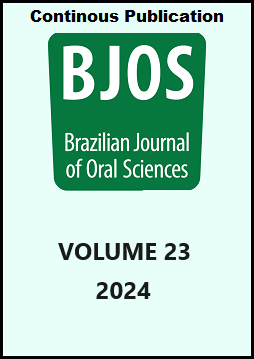Abstract
Aim: Hyposalivation and dry mouth affect the quality of life in patients with Head and Neck Cancer, who did the treatment with radiotherapy. Thus this study has the objective to evaluate the dosimetric relationship between 3D radiotherapy and changes in salivary flow, xerostomia and quality of life in patients with head and neck cancer according to the volume of the irradiated parotid gland. Methods: 23 patients with cancer in the head and neck area and in need of 3D radiotherapy were followed up during radiotherapy treatment, and the parotid gland (PG) design was also performed in radiotherapy planning. Questionnaires were carried out to determine xerostomia and quality of life, while the salivary flow was determined through calculations regarding the collection and weighing of saliva. Such data were collected in three moments: before the beginning of the radiotherapy treatment (D0), in the middle of the treatment (D1) and at the end of it (D2). The numerical variables are represented by measures of central tendency and measures of dispersion. Results: when associating the salivary flow, the xerostomia questionnaire and the OHIP-14, a statistically significant difference was found (p-value <0.001), as well as when comparing some volumes of irradiated PG with the OHIP-14. However, no relationship was found between dosimetric data, xerostomia and hyposalivation. Conclusion: patients undergoing 3D radiotherapy for malignant neoplasms in the head and neck region had decreased salivary flow, increased complaints of dry mouth and decreased quality of life. However, it was not possible to establish a statistically significant correlation between these findings and the volumes of irradiated parotids.
References
Brazilian Ministry of Health. José Alencar Gomes da Silva National Cancer Institute. [2020 estimate: incidence of cancer in Brazil]. Rio de Janeiro: INCA; 2019 [cited 2021 Jun 10]. Available from: https://www.inca.gov.br/sites/ufu.sti.inca.local/files/media/document/estimativa-2020-incidencia-de-cancer-no-brasil.pdf. Portuguese.
Brazilian Ministry of Health. Secretariat of Health Care. National Cancer Institute. [TNM: classification of malignant tumors]. 6.ed. Rio de Janeiro: INCA; 2004. Portuguese.
Moura JFB, Lima RP. [Head and neck tumors]. In: Salvajoli JV, Souhami L, Faria SL, organizers. [Radiotherapy in oncology]. São Paulo: Atheneu; 2013: p.505-15.
Sung H, Ferlay J, Siegel RL, Laversanne M, Soerjomataram I, Jemal A, et al. Global Cancer Statistics 2020: GLOBOCAN Estimates of Incidence and Mortality Worldwide for 36 Cancers in 185 Countries. CA Cancer J Clin. 2021 May;71(3):209-49. doi: 10.3322/caac.21660.
Berman AT, Plastaras JP, Vapiwala N. Radiation oncology: a primer for medical students. J Cancer Educ. 2013 Sep;28(3):547-53. doi: 10.1007/s13187-013-0501-1.
Freedman L, Sidani C. A radiation oncologist's guide to contour the parotid gland. Pract Radiat Oncol. 2016 Nov-Dec;6(6):e315-7. doi: 10.1016/j.prro.2016.05.003.
Beetz I, Steenbakkers RJHM, Chouvalova O, Leemans CR, Doornaert P, van der Laan BFAM, et al. The QUANTEC criteria for parotid gland dose and their efficacy to prevent moderate to severe patient-rated xerostomia. Acta Oncol. 2014 May;53(5):597-604. doi: 10.3109/0284186X.2013.831186.
Jensen SB, Pedersen AML, Vissink A, Andersen E, Brown CG, Davies AN, et al. A systematic review of salivary gland hypofunction and xerostomia induced by cancer therapies: management strategies and economic impact. Support Care Cancer. 2010 Aug;18(8):1061-79. doi: 10.1007/s00520-010-0837-6.
Acauan MD, Figueiredo MA, Cherubini K, Gomes AP, Salum FG. Radiotherapy-induced salivary dysfunction: Structural changes, pathogenetic mechanisms and therapies. Arch Oral Biol. 2015 Dec;60(12):1802-10. doi: 10.1016/j.archoralbio.2015.09.014.
Brouwer CL, Steenbakkers RJ, Langendijk JA, Sijtsema NM. Identifying patients who may benefit from adaptive radiotherapy: Does the literature on anatomic and dosimetric changes in head and neck organs at risk during radiotherapy provide information to help? Radiother Oncol. 2015 Jun;115(3):285-94. doi: 10.1016/j.radonc.2015.05.018.
Fávaro RAA, Ferreira TNR, Martins WD. [Xerostomia: etiology, diagnosis and treatment]. Clin. Pesq. Odontol. 2006 Apr/Jun;2(4):303-17. Portuguese.
Vidal AKL. [Importance of dentistry for cancer patients]. In. Marques CLTQ, Barreto CL, Morais VLL, Kima Júnior NF, organizers. [Oncology a multidisciplinary approach]. Recife: Carpe Diem; 2015. Chapter 104. Portuguese.
Eisbruch A, Ship JA, Dawson LA, Kim HM, Bradford CR, Terrell JE, et al. Salivary gland sparing and improved target irradiation by conformal and intensity modulated irradiation of head and neck cancer. World J Surg. 2003 Jul;27(7):832-7. doi: 10.1007/s00268-003-7105-6.
Thomson WM, Chalmers JM, Spencer AJ, Williams SM. The Xerostomia Inventory: a multi-item approach to measuring dry mouth. Community Dent Health. 1999 Mar;16(1):12-7.
Sreebny LM, Arjan Vissink. Dry mouth: the malevolent symptom: a clinical guide. Ames, Iowa: Wiley-Blackwell; 2010.
Navazesh M, Kumar SK; University of Southern California School of Dentistry. Measuring salivary flow: challenges and opportunities. J Am Dent Assoc. 2008 May;139 Suppl:35S-40S. doi: 10.14219/jada.archive.2008.0353.
Oliveira BH, Nadanovsky P. Psychometric properties of the Brazilian version of the Oral Health Impact Profile-short form. Community Dent Oral Epidemiol. 2005 Aug;33(4):307-14. doi: 10.1111/j.1600-0528.2005.00225.x.
Slade GD. In Inglehart MR, Bagramian RA ,editors.) Oral Health-Related Quality of Life. , Illinois: Quintessence Publishing; 2002.
Messmer MB, Thomsen A, Kirste S, Becker G, Momm F. Xerostomia after radiotherapy in the head & neck area: long-term observations. Radiother Oncol. 2011 Jan;98(1):48-50. doi: 10.1016/j.radonc.2010.10.013.
National Comprehensive Cancer Network (NCCN), Clinical Practice Guidelines. Head and Neck Cancers. Version 3.2019.
Jemal A, Vineis P, Bray F, Torre L, Forman D. The cancer atlas. Atlanta: American Cancer Society; 2016.
Barkokebas A, Silva IHM, de Andrade SC, Carvalho AAT, Gueiros LAM, Paiva SM, et al. Impact of oral mucositis on oral-health-related quality of life of patients diagnosed with cancer. J Oral Pathol Med. 2015 Oct;44(9):746-51. doi: 10.1111/jop.12282.
Trifiletti DM, Smith A, Mitra N, Grover S, Lukens JN, Cohen RB, et al. Beyond positive margins and extracapsular extension: evaluating the utilization and clinical impact of postoperative chemoradiotherapy in resected locally advanced head and neck cancer. J Clin Oncol. 2017 May;35(14):1550-60. doi: 10.1200/JCO.2016.68.2336.
Sanguineti G, Ricchetti F, Wu B, McNutt T, Fiorino C. Parotid gland shrinkage during IMRT predicts the time to Xerostomia resolution. Radiat Oncol. 2015 Jan 17;10:19. doi: 10.1186/s13014-015-0331-x.
McMillan AS, Pow EH, Leung WK, Wong MC, Kwong DL. Oral health-related quality of life in southern Chinese following radiotherapy for nasopharyngeal carcinoma. J Oral Rehabil. 2004 Jun;31(6):600-8. doi: 10.1111/j.1365-2842.2004.01383.x.

This work is licensed under a Creative Commons Attribution 4.0 International License.
Copyright (c) 2024 Ana Waleska Pessôa Barros de Aguiar, Luiz André Nadler Lins, Ana Luíza Fassizoli da Fonte, Raylane Farias de Albuquerque, Jair Carneiro Leão, Igor Henrique Morais Silva


